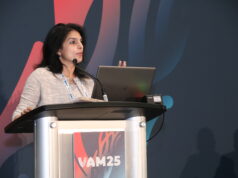
These remain early days for transcatheter arterialization of the deep veins (TADV) in the setting of patients with severe chronic limb-threatening ischemia (CLTI), says Daniel Clair, MD, one of the principal investigators in key clinical trials of the procedure, but the learning-curve process promises that “we are going to continue to see slow but not insignificant improvement in results” with the technique.
“Even within all of the PROMISE trials, you’re talking about only 250 patients that have been assessed, published and looked at carefully,” says the professor and chair of the Department of Vascular Surgery at Vanderbilt University Medical Center in Nashville, Tennessee. “There is still a lot to learn.”
Late last year, Clair presented two-year outcomes from the prospective, multicenter, single-arm PROMISE II trial of the LimFlow system (Inari Medical) for TADV in so-called no-option CLTI patients at the 2024 edition of Vascular Interventional Advances (VIVA) in Las Vegas (Nov. 3–6), demonstrating sustained limb salvage and wound healing.
All patients enrolled in the trial had Rutherford class 5/6 disease, with a total of 105 CLTI patients undergoing the procedure between 2018 and 2022. At VIVA, Clair reported a limb salvage rate of 65% and improvement in Rutherford classification: 65.8% of patients had class 4 or below and 54.3% had class 0. Wounds were completely healed/healing in 82% of patients and the mean pain score was 1.2 out of 10. When combined with the PROMISE I trial, the two-year limb salvage rate was 68%, with no differences observed based on age, sex, race, baseline Rutherford classification, diabetes or dialysis, Clair had added.
Those type of data are likely to be built upon, with the future portending wider use of TADV, Clair reflects in a recent interview with Vascular Specialist.
“What is likely is that you are going to see an expansion in the use of this technology in patients who perhaps are not as far down the path of ischemia as we have seen,” he explains. “I also think that there will likely be some complementary role in terms of arterial revascularization in people who have very bad distal disease.”
The data show that 25–30% continue to lose their limbs even when TADV is used, so opportunities to enhance benefits from the procedure require exploration, Clair continues. “The use of deep vein arterialization with vascular growth factors to enhance angiogenesis in the foot might be ideal. Right now, we are trying to understand how to optimize the venous flow in the foot to enhance, expedite and speed up the arterialization and delivery of oxygen to the tissues in the foot so we don’t lose the forefoot or toes, but we get them this delivery of oxygenated blood so they can heal the wounds that they have. Part of what we’re doing is trying to look at the angiographic and duplex data from PROMISE I and II patients to see if we can identify who are the patients who did really well and the patients who did not do well, and can we identify differences between them.”
Clair is clear on this direction of travel. The patient population who informed the clinical trials typify the necessity of the procedure, he says. “In the past, essentially everyone I have enrolled in these trials is a patient who likely would have had an amputation, and I can say that because I have watched them worsen before enrolling them having tried other measures to help get them through. In the PROMISE trials, we carried this out in what I call the sickest of this group of patients, because they had to be externally validated as having no option; they had to be more than a month out from any previous angiogram or attempted intervention; and they had to have a wound on their foot in order to allow them to qualify. One of the critical issues now is, while that was what the trial was, in the community this technology is being used more in patients who don’t have good options, but who get an angiogram, can’t have percutaneous intervention, and the next day they are going for this venous arterialization.”
In his own practice, Clair has seen previous non-believers in the technology start to embrace it and make referrals. His previous involvement in angiogenesis trials underscore how sick the PROMISE patients are, he says: in those, patients who had rest pain, severe claudication, and no foot wound could be enrolled. “[PROMISE trial participants] are patients who have not been studied in any previous trial because, frankly, they are sicker than any company was willing to look at, particularly in interventional trials.”
Some form of forefoot amputation is not unusual in the first two to three months after TADV, nor is an increase in pain in the first month, PROMISE data reveal. “It’s unusual for these patients to keep everything because they have such severe disease in the foot by the time they presented for treatment with this therapy,” Clair points out. “Intriguingly, in PROMISE I, with every patient who kept their limb, if you made it three months with their limb on, they were going to keep their limb for the long term. In PROMISE II, there were very few patients who lost their limb beyond that first three-to-four-month period. If you get a good venous arterialization, and you see a response through six to 10 weeks, these people are likely going to keep their limb.”
Meanwhile, PROMISE III will take another extended look at the same group of patients “in a little more real-world applications,” Clair adds. “So many of these patients have bilateral limb ischemia, so we included patients in whom you could do the procedure on both sides. We did not mandate an independent review committee; we did not mandate a 30-day waiting period between a previous angiogram or attempted intervention and moving on to venous arterialization.”












